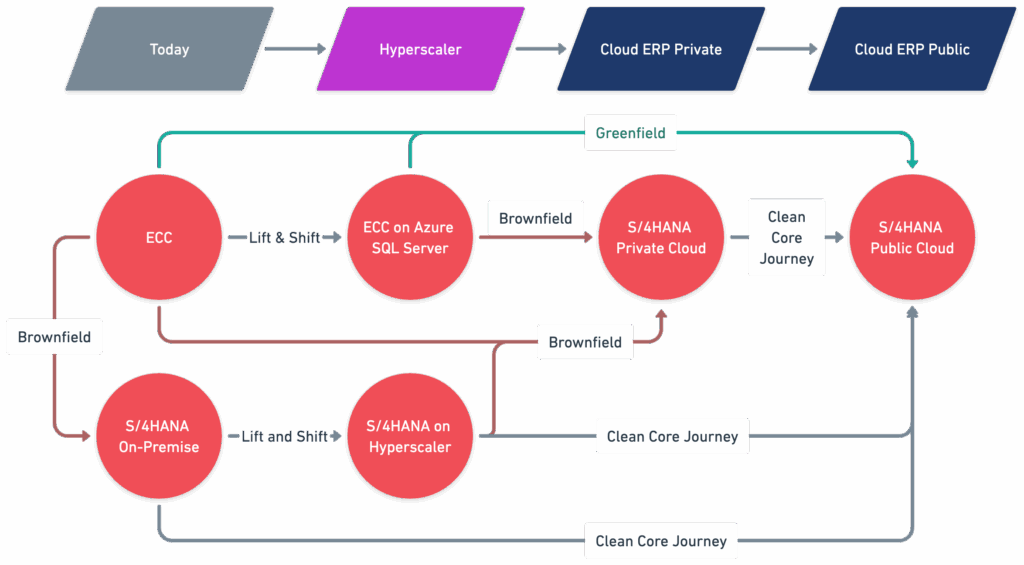In Part 2 of this series, we explored the challenges of change management during a migration or upgrade project. For most businesses, freezing change for the calendar duration of a project the size of a Cloud ERP migration is an entirely impractical request. So, managing concurrent change is a requirement.
With complex Cloud ERP migrations, another requirement is hybrid management: running legacy and new systems during the transition period. Think candidly about your own SAP estate: How long between the start of your first Cloud ERP migration project and the final retirement of the last on-premises ERP system? That’s your hybrid timeline. It’s probably measured in years.
Cloud in the front, legacy in the back
How you approach Cloud ERP migration has a significant impact on hybrid management requirements during the project. Organizations adopting a ‘lift and shift’ approach – moving data and existing systems to Cloud environments – enjoy the most straightforward initial migration. However, this re-platforming on Cloud infrastructure, while still valuable, only changes where and what is managed. There’s no real impact on what management is required, and it’s essentially the status quo running on new infrastructure.

Greenfield deployments transform existing ERP systems leaving technical debt behind. Only the data moves to a new system, enabling all new processes and a new management infrastructure. These are the most complex and time-consuming migrations, leaving the customer to continue to manage existing systems for some time until the new solution is fully online. However, once online, legacy systems can be effectively retired, and there’s a level of appeal with the Greenfield approach in this regard.
In practice, however, fewer large enterprises with multiple SAP landscapes are choosing Greenfield initially because of project size, complexity, and cost. The consequences of a project failure are much higher as well, increasing risk.
So, most large enterprises with complex SAP estates elect an incremental path to the Cloud, either with a lift-and-shift technical upgrade as a first step, or Brownfield migration to S/4HANA and SAP Private Cloud ERP.
Half-past Cloud
Earlier in the series, we explored the requirements for retrofit, and during the transition period, this essential technology comes into play. At some point in your Cloud ERP migration project the Cloud instance will come online. It won’t be production yet, but the work has begun and it’s getting closer by the day. How many days depends on the path to Cloud ERP chosen, of course.
If a requirement for change comes during this period, the change must be made in both existing legacy production systems and this new environment, keeping both in sync until cutover. The movement of change from the current business-as-usual system to the new project landscape, in this case Cloud ERP, is retrofit. And it’s essential that the process be performed perfectly since a failure here results in the reintroduction of old code and functionality to the business when the new system goes live. The complexity of any given change varies considerably based on:
- The chosen path to the Cloud
- The complexity of the change itself
- The compatibility of the change between the existing legacy production environment and the new Cloud ERP platform
Legacy lingers
Until the Cloud ERP solution is live, or until the last legacy environment is retired, you have two environments to manage and keep synchronized. The standard tooling provided by SAP has a reputation for good support in the on-premises world – Solution Manager’s ChaRM – and in the Cloud ERP world – Cloud ALM. However, neither solution is designed for managing both environments concurrently from a single point of control and coordinating change between them.
So, when considering a solution for the transition period, look for a best-of-both-worlds solution, and consider the following common requirements for customers with existing complex SAP estates migrating to Cloud ERP:
- Allow for flexible, dynamic transport path configurations, including branch and merge capabilities. Support complex, multi-tier landscapes and N+n configurations. Anticipate frequent changing infrastructure
- Unified support across all SAP change types from core ABAP to Cloud and integrated traceability from requirements to retrofit, ensuring traceability and audit, even when synchronizing change not directly compatible across environments
- Allow for an iterative approach to clean core for non-Greenfield migrations
- Support DevOps and integrations with DevOps and ITSM tooling
- A single pane of glass for audit, governance and regulatory reporting – this is especially true for GxP and ISO9001 regulated environments
- Solution support beyond 2025/2027/2030/2033
Wrap up and out
A well-planned Cloud ERP migration has a high probability of success. Spend some time exploring your organization’s needs for a Cloud ERP solution and use the insights to select the best fit from the many Cloud ERP options available. Then, carefully plan the midpoint of the migration when change will exist in parallel in two environments at once. Mistakes can cause real headaches, such as reintroducing defects, non-compliant code or even an outage. Plan your legacy system retirement with a solution for the centralized management of change across legacy and Cloud environments until you are fully operational on new Cloud ERP solutions.
If you need help along the way, or want more information about Private Cloud ERP and how Rev-Trac supports RISE Private Cloud, contact one of our SAP change management professionals.

